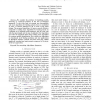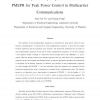8431 search results - page 139 / 1687 » Algorithmically Independent Sequences |
120
click to vote
BIBM
2009
IEEE
15 years 1 months ago
2009
IEEE
—We consider the problem of identifying motifs, recurring or conserved patterns, in the sets of biological sequences. To solve this task, we present new deterministic and exact a...
TIT
2011
14 years 5 months ago
2011
New families of near-complementary sequences are presented for peak power control in multicarrier communications. A framework for near-complementary sequences is given by the expl...
COCO
2003
Springer
15 years 3 months ago
2003
Springer
We review and slightly strengthen known results on the Kolmogorov complexity of prefixes of effectively random sequences. First, there are recursively random random sequences su...
ACL
2009
14 years 7 months ago
2009
The tree sequence based translation model allows the violation of syntactic boundaries in a rule to capture non-syntactic phrases, where a tree sequence is a contiguous sequence o...
100
click to vote
ACL
2010
14 years 8 months ago
2010
The Viterbi algorithm is the conventional decoding algorithm most widely adopted for sequence labeling. Viterbi decoding is, however, prohibitively slow when the label set is larg...


